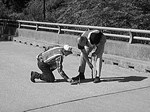U.S. Department of Transportation
Federal Highway Administration
1200 New Jersey Avenue, SE
Washington, DC 20590
202-366-4000
Focus
| Accelerating Infrastructure Innovations |
Publication Number: FHWA-RD-01-060
Date: January 2001
For all the sophisticated technology employed in bridge design and construction today, the maintenance and preservation of bridges still depends largely on regular visual inspection of the structures. The visual inspection method, in fact, is the predominant nondestructive evaluation technique used for bridge inspections in the United States. Beginning in 1998, the Federal Highway Administration's (FHWA) Nondestructive Evaluation Validation Center undertook a comprehensive study to examine the reliability of this method for highway bridges. The study was designed to measure the accuracy and reliability of both routine and indepth inspections, study the influence of key factors that might affect bridge inspector performance, and examine differences in State inspection procedures and reporting styles. The results have shown that the methods used and data collected in routine inspections can vary considerably from State to State.
The study consisted of a review of existing literature on the topic, a survey of bridge inspection agencies, and a series of performance trials involving 49 State department of transportation bridge inspectors. The performance trials were conducted on bridges in Northern Virginia and south central Pennsylvania. Researchers collected data on the results of the inspections, the characteristics of the inspectors, and the inspection environment. The primary data used to evaluate the routine inspections were the National Bridge Inspection Standards Condition Ratings assigned by the inspectors to the primary bridge components (deck, superstructure, and substructure). The condition ratings, which range from 0 to 9, describe both the degree of bridge deterioration and the extent to which it is distributed throughout the structure's components. The primary data used to evaluate the indepth inspections were the inspectors' field notes, which summarize specific deficiencies identified in the bridge.
 |
 |
| As part of FHWA's visual inspection performance trials, inspectors work together to perform a deck delamination survey (left above), while another inspector measures joint seperation during a routine inspection (right above). | |
The study showed that routine inspections are completed with significant variability, particularly with respect to the assignment of condition ratings. During the performance trials, on average four or five different condition rating values were assigned to the bridges' primary components. The frequency with which field notes are taken also varies considerably from State to State. Inadequacies with the indepth inspections were noted as well-specifically, most of the inspectors did not make note of the types of defects, such as weld cracks, that this type of inspection is designed to identify. Factors that may affect indepth inspection results include the structure's complexity and accessibility, the inspector's comfort with the working height and access equipment used, and the inspector's visual acuity.
Recommendations made by the study for improving the accuracy of visual inspections include:
As these recommendations are reviewed by State highway agencies, contractors, and others, "I think we will see some changes in bridge inspections in the next 5 years," says Brent Phares of FHWA's Nondestructive Evaluation Validation Center. "I think we will also see some major revisions to the National Bridge Inspection Standards." For more information or to obtain a copy of the study, contact Brent Phares at 202-493-3121 (fax: 202-493-3126; email: brent.phares@fhwa.dot.gov).